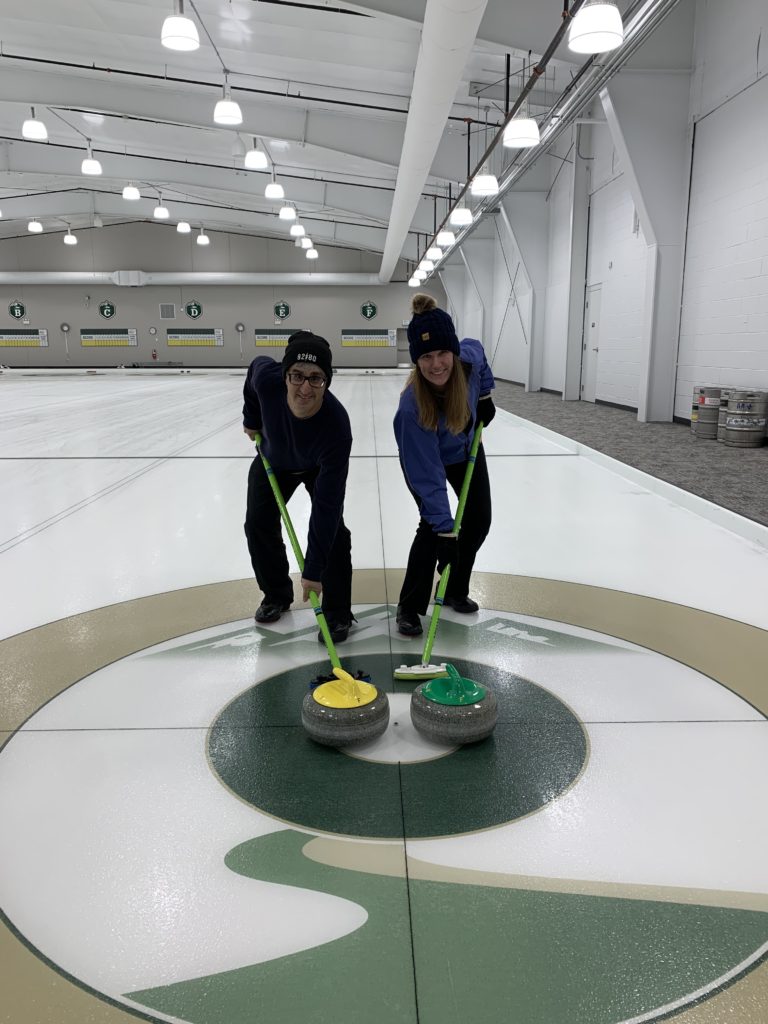We humans start planning our future from the time we first learn to speak in complete sentences. “Someday I’m going to go to Mars!” or “I’m going to remove my big brother’s brain and replace it with a monkey brain.” We’re not, at that young age, aware that these are actually bucket list items. In case you’re not familiar with the term, a bucket list is a catalog of those things you want to do at least once before you die. (Morose? Sure. Why not.)
Having goals you can accomplish is much more satisfying, and as you get older, your bucket list reflects that. This is how and why Kristen and I found ourselves on a sheet of ice to try curling last week.
How Curling and I Found Each Other
When my first wife and I separated in February of 2002, it was at the height of the Winter Olympics in Salt Lake City. If you’ve ever been through a tough break-up, you know how painful it can be. When you’re married, it’s that times a thousand. I found myself feeling antisocial that winter, spending most nights on the couch, zoning in front of the TV. And what was on the TV? What seemed to be on the TV every hour of the day? If you said Seinfeld reruns, you’re probably right, but I’m talking about Olympic curling. (Try to keep up, okay?)
If you’re not familiar with curling, it’s a strange little game. Invented by the Scottish (who also gave us golf, the bastards), curling is a weird, icy version of shuffleboard. Or so I’m told. I’m old, but not so old that I have any idea how to play shuffleboard. In curling, there are two teams of four players, and they take turns sliding heavy stones (42 pounds each!) down a sheet of ice toward a target with a bullseye. The team with the stone closest to the center of the bullseye, scores points. What makes it weird is the sweeping.
After the stone (colloquially called “the rock”) is released from the slider’s hand, his or her teammates run ahead of said rock (running on ice, by the way), using a special broom, to sweep in front of it. The main goal for the sweeper is to create friction and heat in the path of the rock, giving the throw extra distance. At the Olympic level, sweeping can add as much as ten feet, or so we were told. Heavy use of the broom can also slightly alter the direction of the stone.
Watching curling on television was, for me, almost hypnotic. I couldn’t tear my eyes away from it. Something about the sport was just…beautiful. With each Winter Olympics since 2002, I’ve tuned in to watch the curlers from around the globe. I would often joke that curling was my last chance to stand on an Olympic podium. (And yes, as a kid, winning a gold medal was definitely on my bucket list.) I mean, how hard could it be? Can’t anyone do this? Isn’t it like bowling? Or shooting pool?
Everything I Needed to Know about Curling
If I had stopped think about it before Kristen and I signed up for an introductory course at the Rock Creek Curling Club in Lafayette Colorado, I would have remembered that I’m terrible at both bowling and pool. But stopping to think about things is not really my signature move. Here’s what I learned about curling in our 75 minute session: It’s hard. Really hard. Let me break it down for you.
- You’re given a pair of curling shoes (hello again, bowling), one of which has grips on the bottom, the other, teflon. Have you ever slid a teflon pan on a sheet of ice? (You have? Really? You might want to re-examine some of your life choices.) If not, it is virtually frictionless. So while one foot stays anchored, the other wants to slide every which way. Even standing is a challenge at first.
- Like every sport, the adherents have developed their own lingo. There’s a hogline, the hack, the house (no, I’m not sure why curlers are fascinated with the letter H) that each have their own unique meaning.
- When you squat down with your grippy foot in the hack (like a sprinter’s starting block), you push off while holding the rock in front of you, your weight over the teflon foot, and your other foot trailing behind. Just before you reach the hogline, you let go of the rock, transferring the momentum from your push to the stone — but NOT pushing it with your am — sending it down the ice. Only, the ice is 100 feet long, and you need a lot of momentum to move 42 pounds 100 feet, even if it is on ice. How Olympic curlers send that thing careening at bullet speed is beyond my comprehension.
- People are really nice. I play hockey (not very well), and I’m just not used to that.
Kristen and I were intrigued by our first lesson, but we’re going to hold off before pursuing recreational curling more seriously. Maybe in a year or two, but maybe not. I will say that any hope of Olympic glory in my sunset years evaporated in a puff overheated curling ice. But I did cross something off my bucket list. Bora Bora, you’re next.

